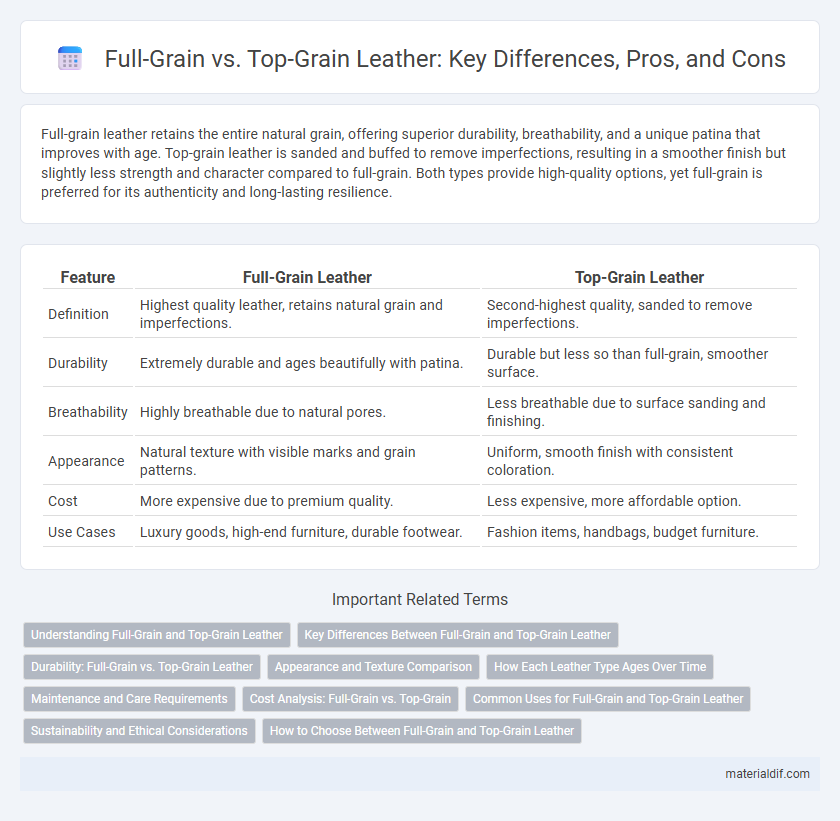Full-grain leather retains the entire natural grain, offering superior durability, breathability, and a unique patina that improves with age. Top-grain leather is sanded and buffed to remove imperfections, resulting in a smoother finish but slightly less strength and character compared to full-grain. Both types provide high-quality options, yet full-grain is preferred for its authenticity and long-lasting resilience.
Table of Comparison
| Feature | Full-Grain Leather | Top-Grain Leather |
|---|---|---|
| Definition | Highest quality leather, retains natural grain and imperfections. | Second-highest quality, sanded to remove imperfections. |
| Durability | Extremely durable and ages beautifully with patina. | Durable but less so than full-grain, smoother surface. |
| Breathability | Highly breathable due to natural pores. | Less breathable due to surface sanding and finishing. |
| Appearance | Natural texture with visible marks and grain patterns. | Uniform, smooth finish with consistent coloration. |
| Cost | More expensive due to premium quality. | Less expensive, more affordable option. |
| Use Cases | Luxury goods, high-end furniture, durable footwear. | Fashion items, handbags, budget furniture. |
Understanding Full-Grain and Top-Grain Leather
Full-grain leather is the highest quality leather, made from the top layer of the hide, preserving the natural grain and offering superior durability and breathability. Top-grain leather has the outermost layer sanded and refinished to remove imperfections, resulting in a smoother surface but slightly less strength and natural texture compared to full-grain. Understanding the differences helps consumers choose between full-grain's rugged authenticity and top-grain's polished appearance for various leather goods.
Key Differences Between Full-Grain and Top-Grain Leather
Full-grain leather retains the entire grain layer, showcasing natural imperfections and providing superior durability and breathability, while top-grain leather is sanded and buffed to remove blemishes, resulting in a smoother, more uniform appearance but slightly less strength. Full-grain leather develops a rich patina over time, enhancing its aesthetic appeal, whereas top-grain leather maintains a consistent finish without significant aging characteristics. The cost of full-grain leather is typically higher due to its premium quality, making it the preferred choice for luxury goods and long-lasting products.
Durability: Full-Grain vs. Top-Grain Leather
Full-grain leather offers superior durability due to its unaltered surface, retaining the natural grain and strength of the hide. Top-grain leather undergoes sanding and refinishing, which slightly reduces its thickness and resilience but still provides good overall durability. The tightly packed fibers in full-grain leather make it more resistant to wear and tear, ideal for long-lasting leather goods.
Appearance and Texture Comparison
Full-grain leather features the natural surface with visible pores and scars, offering a rugged, textured appearance that develops a unique patina over time. Top-grain leather undergoes sanding to remove imperfections, resulting in a smoother, more uniform surface with a refined and polished look. Full-grain feels firmer and more breathable, while top-grain is softer and more pliable due to its thinner, buffed finish.
How Each Leather Type Ages Over Time
Full-grain leather develops a rich patina with age, showcasing natural imperfections and enhancing durability through exposure to sunlight and natural oils. Top-grain leather resists stains and scratches better but tends to develop a uniform, smoother finish that can fade more quickly and lacks the deep character of full-grain aging. Over time, full-grain leather maintains strength and visual appeal, while top-grain leather requires more maintenance to preserve its look.
Maintenance and Care Requirements
Full-grain leather requires minimal maintenance due to its natural surface, which develops a rich patina over time when regularly cleaned and conditioned with leather-specific products. Top-grain leather demands more frequent care, including conditioning and protection from excessive moisture and scratches, to maintain its smooth finish and prevent surface damage. Both types benefit from prompt stain removal and storage in a cool, dry environment to prolong their durability and appearance.
Cost Analysis: Full-Grain vs. Top-Grain
Full-grain leather typically costs 20-30% more than top-grain due to its superior durability and natural surface retention, which requires less processing. Top-grain leather undergoes sanding and buffing to remove imperfections, lowering production costs but reducing longevity and aging quality. Investing in full-grain leather offers better long-term value despite higher initial expenses, as it develops a unique patina and resists wear better than top-grain alternatives.
Common Uses for Full-Grain and Top-Grain Leather
Full-grain leather is widely used in high-end furniture, luxury footwear, and premium saddlery due to its durability, natural texture, and ability to develop a rich patina over time. Top-grain leather is commonly found in fashion accessories, handbags, and automotive upholstery, offering a smoother, more uniform appearance with easier maintenance. Both types serve distinct purposes, with full-grain preferred for rugged, long-lasting products and top-grain chosen for stylish, everyday items.
Sustainability and Ethical Considerations
Full-grain leather stands out for its durability and minimal processing, preserving the hide's natural strength while reducing chemical treatments, which supports sustainable practices. Top-grain leather undergoes more refinement, involving sanding and correction, which can increase waste and environmental impact due to additional chemicals and energy use. Ethical considerations favor full-grain leather from responsible sources, emphasizing traceability and animal welfare, whereas top-grain leather's extensive processing may complicate transparent sustainability assessments.
How to Choose Between Full-Grain and Top-Grain Leather
Full-grain leather maintains the natural surface with all its imperfections, providing superior durability and a rich patina over time, ideal for those seeking longevity and authenticity. Top-grain leather undergoes surface sanding for a smoother, more uniform finish, appealing to buyers who prefer a refined appearance and easier maintenance. When choosing between full-grain and top-grain leather, consider whether durability and natural character or consistent aesthetics and easier care align better with your lifestyle and product use.
Full-grain vs Top-grain Infographic

 materialdif.com
materialdif.com